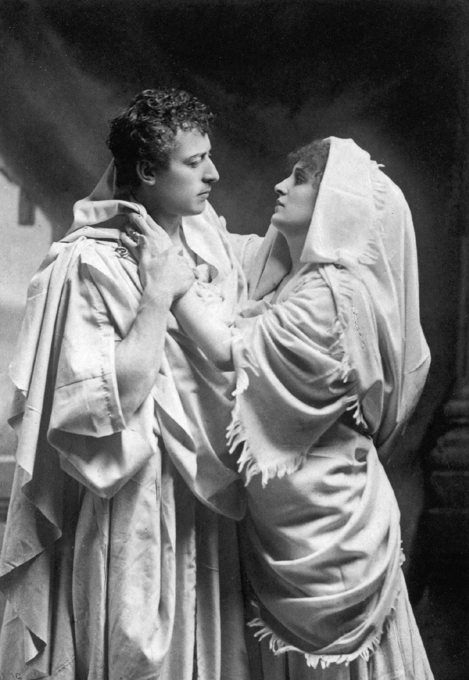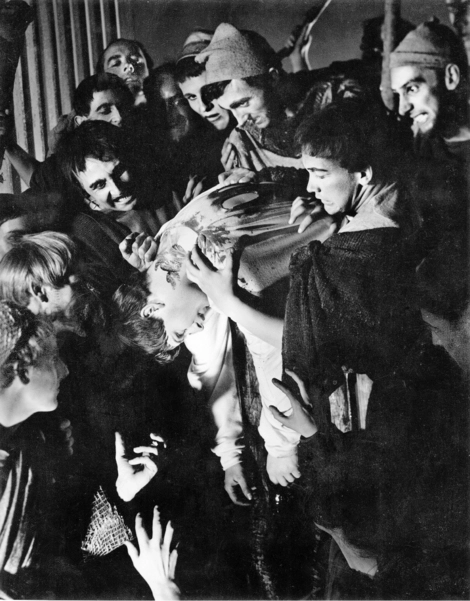It is the feverish, pulsing life of the imperial city.16

1. Herbert Beerbohm Tree, 1898, Her Majesty’s Theatre, with Lewis Miller as Brutus and Evelyn Millard as Portia.
Beerbohm Tree’s hundred-strong crowd dominated the Forum scene and Beerbohm Tree himself played Antony, orchestrating the crowd in a remarkable display of rhetoric and choreography. His choice to centralize Antony necessitated Charles Fulton’s “sympathetic and reformist Caesar,”17 so that Antony’s loyalty could be laudable. The dynamic between Antony and the crowd has often since been choreographed to great effect, notably in Peter Stein’s epic 1992 Salzburg production.
Frank Benson directed several productions at Stratford between 1892 and 1915, also playing Antony: “his action was dignified, his delivery was marked by intensity, intellectual keenness, and impressiveness, and altogether it was a fine study and a striking example of effective and impassioned oratory.”18 Otho Stuart was his best-received Brutus, his “dignified self-possession and measured diction”19 pairing especially well with Henry Ainley’s vehement Cassius.
Beerbohm Tree and Benson’s productions were pro-establishment in their sympathetic treatment of Caesar, and this conservative reading was effectively given royal approval on May 2, 1916. Shakespeare’s tercentenary was celebrated with a Royal Matinee at Drury Lane, during which Benson—playing Caesar “with consummate dignity”20—was called to the Royal Box and knighted.
William Bridges-Adams succeeded Benson at Stratford in 1919 and was the first director to restore a completely uncut text. Reviewers appreciated the additions: where Act 3 Scene 1 had traditionally ended with “Cry havoc and let slip the dogs of war,” the restored scene with Octavius’ servant “gives the key to the future action of Mark Antony,”21 and allowed Bridges-Adams to begin questioning Caesar’s motivations. Later developments included Stanley Lothbury’s “querulous, snarling, decrepit old man” of a Caesar and Baliol Holloway’s Antony as “fawning demagogue” in 1922.22 By 1934, John Wyse’s Brutus “seemed never more noble,” while Eric Maxon’s Caesar succeeded through “restrained force of expression in making Caesar bigger than the Caesar Shakespeare drew.”23 Iris Guillaume’s Calpurnia was cast as a Mary Magdalene figure, though reviews still complained that “women have little place in Julius Caesar.”24 An “interpolated picture of Antony viewing a burning Rome while a beggar clutches at his legs”25 was, however, ridiculed.
The most influential stage production of the century, Orson Welles’s Julius Caesar: The Death of a Dictator, opened at New York’s Mercury Theater in November 1937. Welles “set about to arouse the passions of his audience with a simulation of the chaos then overtaking Europe,”26 rendering the play terrifyingly relevant. The script was severely pared down to focus on Caesar, Brutus, and the mob. One notable inclusion was the restoration of the lynching of Cinna the Poet: “The Mercury audience made Cinna’s experience their own, representing as it did their worst fears for themselves and for those dearest to them abroad.”27 Welles’s self-consciously theatrical production was performed in modern dress, deliberately evoking Mussolini and fascism to generate a sense of pity and horror at atrocities across the Atlantic. The production’s backstage story was turned into a 2009 Hollywood movie, Me and Orson Welles. Antidictatorial readings of the play have since been commonplace: a 1969 production in Minneapolis was set in Latin America with Caesar as “an aspiring sun-god in white and gold,”28 while in Miami in 1986 audiences were “brought to their feet by the spectacle of the assassins bathing their hands in the blood of Caesar as Fidel Castro.”29
Also influential was Joseph L. Mankiewicz’s 1953 motion picture starring James Mason (Brutus), John Gielgud (Cassius), and Marlon Brando (Antony). The Forum scene incorporated 1,200 extras, though the individual performances were praised as much as the grand spectacle. Gielgud played Cassius as “the vulgar abstraction of personal jealousy,”30 while Brando’s physical Antony was “all fire and ice.”31 As with Welles’s stage production, Mankiewicz “understood the tragedy’s message … : Caesar was a Mussolini-like dictator, and Antony his chief factor—A Hitler who realises the fascist dream of his mentor.”32 Stuart Burge directed another film in 1970, but even the presence of Gielgud (Caesar) and Charlton Heston (Antony) couldn’t salvage an obviously cheap and poorly produced production.
In Stratford-upon-Avon, Anthony Quayle and Michael Langham’s 1950 production on an unlocalized stage was fast and efficient: “John Gielgud as Cassius has never before shown such sustained vehemence … Cassius is beyond question the most important person of every scene in which he figures, even when he is stooping low and looking daggers at great Caesar himself.”33 The fickleness of the mob was strongly emphasized, but after the tent scene “the rest is a mopping-up operation of Caesar’s ghost, alarms and excursions, and the inevitable falling on antique swords”:34 a regular complaint against productions. Rare praise was reserved for Portia, from whom Gwen Ffrangcon-Davies “extracts every shade of sympathy and emotion … an exquisite performance, this, sad with a melancholy that achieves a brief and touching beauty,”35 but Quayle’s own performance as Antony was “obliterated” by the mob.
Glen Byam Shaw’s 1957 Stratford production was played in togas against a backdrop of pillars. Returning the focus to Brutus, Alec Clunes was a “liberal idealist all too closely snared by more self-interested conspirators.”36 Mark Dignam’s sardonic Casca, played with “a neatly calculated edge of rueful self-enjoyment,”37 was singled out for particular praise by all reviewers, the part continuing to stand out; while the interval curtain fell on the image of “Cinna, the poet, wrongfully stoned to death by the crowd, hanging over the pulpit of the Forum from which Mark Antony has inspired a city’s mutiny.”38
The play’s popularity on foreign stages has taken various forms. In South Africa, following the public assassination of Prime Minister Hendrik Verwoerd in 1960, “productions of Julius Caesar became charged with an increased energy, became, in a sense, symbolic re-enactments of the assassination of Verwoerd, who himself had come to signify the ideals of Grand Apartheid.”39 During the apartheid era, productions were generally read as conservative and anti-revolutionary, a demonstration of the penalty for violent uprising. In Munich in 1955, conversely, Fritz Kortner aimed for ambivalent responses: at the moment of assassination, Brutus “hesitated, and there was a long agonizing pause before ‘he resolved matters with his stab to the heart.’ ”40 Of more interest to Kortner than judgments of “right” or “wrong” was the mindless butchery into which the climactic violence descended.
The Shakespeare Festival at Stratford Ontario has produced the play several times. In 1978, an excitingly experimental production by John Wood received rave reviews. In brooding darkness, the stage was suddenly illuminated during the assassination: “so great was the contrast that the white light in which the slaying was bathed seemed blinding and almost obscene … the event seemed as ritualized as an act of purification and as appalling as an act of desecration.”41 The production took the further innovation of removing the mob altogether, leaving Antony alone onstage for a funeral oration that acted as psychological self-exploration. In 1982, Derek Goldby’s production “offended many critics with its harsh violence and its forceful but simplistic treatment of mob psychology.” While individual performances were weak, its “vision of a system tearing itself apart”42 was compelling.

2. Glen Byam Shaw’s 1957 Stratford production: “the interval curtain fell on the image of ‘Cinna, the poet, wrongfully stoned to death by the crowd.’ ”
Gielgud returned to the role of Caesar for the National Theatre in 1977: “For once the man dominates, in death as in life: Gielgud suggests both his greatness and why the conspiracy came to a head.”43 His Ghost hovered over the final proceedings, projecting a spirit of revenge and indomitability. However, the rest of the production failed to impress: Brian Cox’s Brutus, whose “ringing tones betray the unworldly idealism of the born loser,”44 was praised, but the lack of a “sense of impending, or actual, tyranny” rendered the production “apolitical” and “dreary.”45
Herbert Wise’s 1978 BBC film featured a strong cast including Richard Pasco (Brutus) and Charles Gray (Caesar). Unapologetically Roman in setting, this production utilized the possibilities of television to create a conspiratorial atmosphere, particularly in the opening temptation of Brutus: “We watch Cassius’s face past the back of Brutus’s head. Until Cassius circles his auditor, we do not know for certain how Brutus is responding. As positions shift, Wise gets an extreme close-up of Brutus’s face; we see his eyes as an eyebrow lifts.”46 A voice-over, meanwhile, betrayed his thoughts only to the audience. The film as a whole, however, felt studio-bound and static.
More recently, a 1999 original-practices experiment at the reconstructed Globe Theatre received mixed reviews: the Guardian felt it offered “no visible interpretation of the play,”47 while the Telegraph found it “comes over with freshness and strength.”48 The mixed costume (Roman, Elizabethan, and modern) served to suggest “what a live and touchy issue the play’s subject—the ethics of tyrannicide—must have been for the original audiences.”49
Deborah Warner’s 2005 Barbican production hearkened back to earlier spectaculars with a hundred-strong crowd that was particularly praised: “Head-scarfed and dreadlocked, furious and stunned, surging and chanting behind metal barriers, it gives urgency and variety to a play unappetisingly made up of committee men and soldiers.”50 Warner’s modern-dress production was severe on media manipulation and public image: Ralph Fiennes’s Antony “gets giddily high on the fans’ frenzy,”51 while the Soothsayer was an attention-seeking drunk. In a concurrent production on Broadway directed by Daniel Sullivan, Denzel Washington’s Brutus was accused of mangling the verse: “much of what comes out of his mouth is undifferentiated mush.” He was the star attraction of a “colourless” Eastern European-set production that compensated for a lack of focus following Caesar’s death with “plenty of plaster-cracking explosions.”52
Other twenty-first-century productions have chosen to focus on the conspiracy and intrigue as reflective of modern politics. The intimacy of Bristol’s Tobacco Factory allowed Andrew Hilton’s 2009 production to be played in near-whispers, and Jacobean cloaks and hats evoked the famous image of the Gunpowder Plot as a key reference point (a costume decision also taken in 1986 by David Thacker’s production for the Young Vic), yet the powerful Act 4 Scene 1 suggested the callousness of modern bureaucracy as Antony literally signed away his nephew’s life. Toneelgroep Amsterdam’s 2009 Roman Tragedies more explicitly updated Rome to the anonymous “corridors of power” of modern politics. Here, Renée Fokker’s Cassius was a female politician trying to make her way in a man’s world, and needed the validation of Roeland Fernhout’s Brutus for her coup.
1 comment